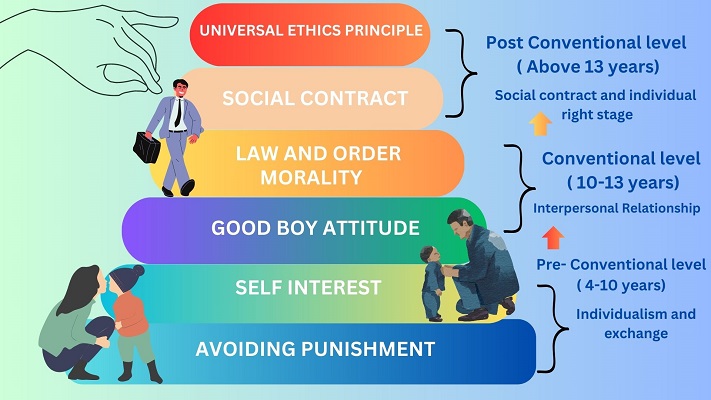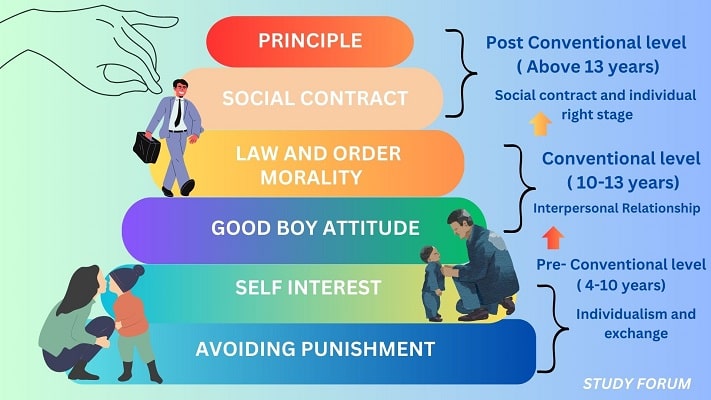In this article, we would like to study about KOHLBERG’S Theory of Moral Development which is a modified form of Piaget’s cognitive development theory. Moral development in children means that they can differentiate between right and wrong. Morality is developed in children by society. Morality is not an innate quality, it develops in children by living in society.
This theory deals with how morality and moral reasoning develops in a person. Kohlberg proposed the Moral Development Theory in 1969 and revised it twice in 1981 and 1984. Moral development is nothing but differentiating capability between what is right and what is wrong. Moral reasoning is a logical power to take decisions in confusing situations. Developing an understanding of what is wrong and what is right, is called moral development. This theory is inspired by Jean Piaget’s cognitive development theory.
Kohlberg used to do experiments to create his theory and he used stories in his Experiments. He used to tell stories based on moral values to the group of students he used to Experiment with. Moral dilemmas were presented in the form of stories in front of children in the age group of ten to sixteen years and interviews based on these dilemmas were taken. Many moral dilemmas related to following the rules or instructions of elders were presented in these stories. From the analysis of the information obtained from these interviews, Kohlberg has given three major levels and six stages of moral development which are presented in Table below.

Contents
Levels and stages of KOHLBERG’S Theory of Moral Development:
| Level | Stage |
| 1. Pre- Conventional level ( 4-10 years) | A. Obedience and Punishment B. Individualism and exchange |
| 2. Conventional level ( 10-13 years) | C. Interpersonal Relationship D. Maintaining social order |
| 3. Post Conventional level ( Above 13 years) | E. Social contract and individual right stage F. Universal Ethics Principles |
1. Pre-Conventional level (4-10 years):
A. Obedience and Punishment:
Development of mortality due to fear of punishment.
B. Individualism and exchange:
Development of such kind of morality such as if you give me some toys then I will be obedient to you. Another example as I will share my book if you share your book with me. Just like tit-for-tat condition.
2. Conventional level (10-13 years):
C. Interpersonal Relationship:
In this stage, a boy or a girl wants to be good in society/ group/ school, etc. The child works in such a way that everyone should think that I am a good boy or I am a nice girl.
D. Maintaining social order:
In this stage of moral development child starts following the rules and regulations of society and maintains social rules and order.
3. Post-Conventional level (Above 13 years):
E. Social contract and individual right stage:
In this stage of moral development, a child knows his rights in society.
F. Universal Principles:
In this stage, a person wants to be an ideal/iconic person in society or in the country. He wants to be like Mahatma Gandhi, Nelson Mandela, etc.
Criticism of Kohlberg’s moral development theory:
While performing his experiment, he had only taken males into consideration. That’s why his theory is called a gender-biased theory. According to Carol Gilligan ( who was a student of Lawrence Kohlberg) this theory does not consider a feministic perspective and this was the main criticism of Kohlberg’s Moral development theory.
MCQs on Kohlberg’s Theory of Moral Development
Q.1 Moral development theory is given by?
i. Jean Piaget
ii. Lev Vygotsky
iii. Kohlberg
iv. Pavlov
iii) Kohlberg
Q.2 Which of the following is not a level of Kohlberg’s moral development theory?
i. Pre-operational level
ii Conventional level
iii. Post-conventional level
iv. Pre-conventional level
i) Pre – operational level
Q.3 Kohlberg’s moral development theory has?
i. 3 levels, 3 stages
ii 3 levels, 6 stages
iii. 6 levels, 6 stages
iv. 6 levels, 3 stages
ii) 3 level, 6 stages
Q.4 In reference to Kohlberg’s Moral development theory stages, A student said to his classmate,” Your family will feel proud of you if you are obedient that’s why you should be obedient.” Student belongs to which of the following stage?
i. Obedience and Punishment Orientation
ii. Individualism and exchange orientation
iii. Good boy nice girl orientation.
iv. Social contract and individual rights stage.
iii)Good boy nice girl orientation
Q.5 In reference to Kohlberg’s Moral development theory, a child does his homework at school due to fear of punishment. Student belongs to which of the following stage?
i. Obedience and Punishment orientation.
ii. Individualism and exchange orientation.
iii. Good boy nice girl orientation
iv. Social contract and individual right stage
i. Obedience and Punishment orientation.
Q.6. Carol Gilligan ( who was a student of Lawrence Kohlberg) criticized Lawrence Kohlberg’s moral development theory because this theory is based on?
i. Gender Biased
ii Underestimating the potential of students.
iii. Experiment on animals only
iv. Overestimating the potential of the students
i)Gender Biased
Q.7. According to Lawrence Kohlberg’s moral development theory which of the following level include good boy nice girl orientation?
i. Pre-operational level
ii Conventional level
iii. Post-conventional level
iv. Pre-conventional level.
ii)Conventional stage
Q.8. According to Lawrence Kohlberg’s moral development theory which of the following level include the universal ethical principle?
i. Pre-operational level
ii Conventional level
iii. Post-conventional level
iv. Pre-conventional level.
iii)Post Conventional stage
Q.9. In reference to Lawrence Kohlberg’s moral development theory, a person wants to be iconic for all humanity and has a caring nature towards the nation and the public. The person lies in which of the following stage of moral development?
i. Universal ethics principle orientation.
ii. Individualism and exchange orientation.
iii. Good boy nice girl orientation.
iv. Social contract and individual rights stage.
i. Universal ethics principle orientation.
Q.10. Which of the following is the main criticism of Lawrence Kohlberg’s Moral development theory?
i. This theory underestimates the capability of the students.
ii. This theory is only based on the experiment on animals.
iii. This theory only focus on male while experiments.
iv. This theory does not consider various cultures while experiments.
iii. This theory only focus on male while experiments.
Q.11 .The sense of right and wrong is most widely associated with?
i. Sympathy
ii. Empathy
iii. Shame
iv. Morality.
iv)Morality
Q.12. In reference to Lawrence Kohlberg’s moral development theory, a human being’s development of morality is a process of?
i. Progressing through a series of standard stages of morality levels.
ii. Progressing through the hierarchical level in which an individual develops the ability to control emotions
iii. Gradually internalizing values of what is wrong and what is right
iv. Recognizing the things that can help other people and what can cause harm to other people.
i. Progressing through a series of standard stages of morality levels.
Q.13 Ram is traveling with his father. His father drove a car at high speed. Ram criticizes his father for over speeding because over speeding is against the law. According to Lawrence Kohlberg’s moral development theory, Ram belongs to which of the following level?
i. Pre-operational level
ii Conventional level
iii. Post-conventional level
iv. Pre-conventional level.
ii) Conventional level
Q.14. Anshika is a nine-year-old girl. She demands dairy milk chocolate from her mother to bring vegetables from the vegetable shop and clearly says that she will not bring vegetables from the shop if you do not give her chocolate. According to Lawrence Kohlberg’s moral development theory, Anshika belong to which of the following stage of moral development?
i. Universal ethics principle orientation.
ii. Individualism and exchange orientation.
iii. Good boy nice girl orientation.
iv. Social contract and individual rights stage.
ii) Individualism and exchange orientation
Q.15. The concept of “tit-for-tat” is the main characteristic of which of the following stage of Kohlberg’s moral development theory?
i. Universal ethics principle orientation.
ii. Individualism and exchange orientation.
iii. Good boy nice girl orientation.
iv. Social contract and individual rights stage.
ii) Individualism and exchange orientation
Q.16. Anshika works very seriously to help the poor escape dangerous conditions that she had witnessed in the Northeast area of India. She believes that it is the right thing to do even though she often finds herself in life-threatening situations while helping the poor. According to Lawrence Kohlberg’s moral development theory, Anshika belong to which of the following stage of moral development?
i. Universal ethics principle orientation.
ii. Individualism and exchange orientation.
iii. Good boy nice girl orientation.
iv. Social contract and individual rights stage.
i) Universal ethics principle orientation


It’s very useful questions for ctet exam preparation…..thank you very much